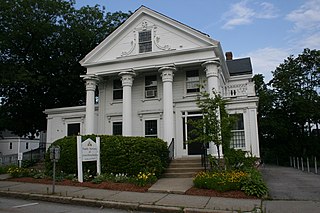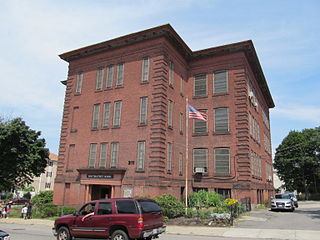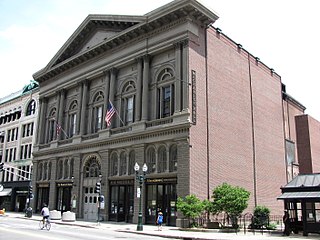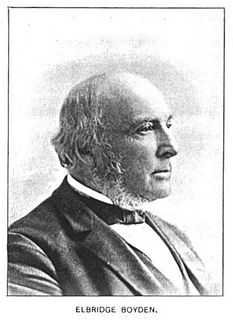
The Cathedral of Saint Paul — informally known as Saint Paul's Cathedral — is the mother church of the Roman Catholic Diocese of Worcester. It is located at 38 Chatham Street in downtown Worcester, Massachusetts. Built between 1868 and 1889, it is one of the city's finest examples of Victorian Gothic architecture, and was listed on the National Register of Historic Places in 1980.

The Brookfield Common Historic District encompasses a historically significant portion of the town center of Brookfield, Massachusetts. It is focused on the town common, which extends south from Main Street to Lincoln Street, and includes a dense cluster of houses on roads to its east, as well as properties on Main Street and the Post Road. The district includes more than 100 properties, including the Colonial Revival Town Hall, Banister Memorial Hall, and Romanesque Revival Congregation Church. The district was added to the National Register of Historic Places in 1990.

The Monument Park Historic District is a historic district centered on Monument Park in downtown Fitchburg, Massachusetts. The district has one of the city's finest assemblages of high-quality architecture, including a number of civic, religious, and commercial buildings near the park. The district was listed on the National Register of Historic Places in 1978.

The Hubbardston Public Library is the public library of Hubbardston, Massachusetts. The library, located at 7 Main Street, serves the town by providing a wide variety of materials, services, and events. It offers Internet access and access to the CWMARS resource-sharing catalog.

The William Trowbridge Forbes House was a historic house at 23 Trowbridge Road in Worcester, Massachusetts. Built in 1898 to a design by Barker & Nourse, it was one of the city's finest examples of Tudor Revival architecture, and was home to Esther Forbes, author of Johnny Tremain. The house was listed on the National Register of Historic Places in 1980. The house was demolished in November 2003.

The Ash Street School is a historic school building at 4 Ash Street in Worcester, Massachusetts, United States. The Italianate style school was built as part of a wave of school construction in the city between 1848 and 1855, and is the city's second oldest surviving school. The building was listed on the National Register of Historic Places in 1980. It is presently home to a local land conservation organization.

The Samuel Copeland House is a historic house located at 31 Harvard Street in Worcester, Massachusetts. Built c. 1847, the elaborate Greek Revival house is one two in the city with a full temple front. The house was listed on the National Register of Historic Places on March 5, 1980.

The Goddard House was a historic house at 12 Catharine Street in Worcester, Massachusetts. Built in 1870, it was a prominent local example of Second Empire architecture, built for a highly placed manager of a major local firm. The house was listed on the National Register of Historic Places in 1980; it was demolished in 1979.

The Henry Goulding House is an historic house at 26 Harvard Street in Worcester, Massachusetts< USA. Built in 1850-51 for a major local industrialist, it is one of the city's most opulent Italianate houses. In 1921, the house became the Swedish Lutheran Home for the Aged after the Goulding heirs gave it to the Swedish Lutheran Church of Worcester. The house was owned by Lutheran Social Services, Inc. in 1980 when the house was added to the National Register of Historic Places. It is now owned by the Sheehan Health Group and is operated as the Lutheran Rehabilitation & Skilled Care Center.

The Grafton Street School is a historic school at 311 Grafton Street in Worcester, Massachusetts. The school consists of two buildings, built in 1879 and 1899, that feature high-quality Late Victorian architecture. The buildings were listed on the National Register of Historic Places in 1980.

The Harris-Merrick House is an historic house at located 41 Fruit Street in Worcester, Massachusetts. Built sometime between 1832 and 1844, it is a good example of Greek Revival architecture, and a rare surviving element of the early residential development west of downtown Worcester. The house was listed on the National Register of Historic Places on March 5, 1980.

Larchmont is a historic house at 36 Butler Street in Worcester, Massachusetts. Built in 1858 as a country house, it is one of the city's finest surviving examples of Italianate architecture. It was listed on the National Register of Historic Places in 1980.

The John Legg House is a historic house at 5 Claremont Street in Worcester, Massachusetts. The Queen Anne style house was built in 1892 to a design by noted local architect Stephen Earle for John Legg, owner of the Worcester Woolens Company, one of the city's largest textile businesses. It is a 2+1⁄2-story wood-frame with an asymmetrical plan. One unusual feature is a first floor bay on the right side which is topped by a parapet. The center and left side of the house are sheltered by a porch, with a decorated gable end over the stairs.

The Jerome Marble House is an historic house at 23 Harvard Street in Worcester, Massachusetts, United States. Built in 1867 to a design by Elbridge Boyden, it is one of the city's fine examples of Second Empire architecture, and one of the few for which an architect is known. The house was listed on the National Register of Historic Places in 1980. It now houses professional offices.

The Mechanics' Hall District is a historic district encompassing a city block of downtown Worcester, Massachusetts, United States that preserves its late 19th-century appearance. It is located on Main Street between Exchange and Foster Streets, and includes the Worcester Five Cents Savings Bank building and Mechanics Hall. It was added to the National Register of Historic Places in 1980.

The Ammidown-Harding Farmhouse is a historic farm house at 83 Lebanon Hill Road in Southbridge, Massachusetts. Built sometime in the 18th century, it is one of Southbridge's few surviving houses from that time. It was added to the National Register of Historic Places in 1989. It is named for two of its notable residents, Cyrus Ammidown and Elbridge Harding, both of whom served as deacons in the Baptist church.

Charles Kirk Kirby, was an American architect who practiced in Massachusetts, Maine, and California.

Elbridge Boyden (1810–1898) was a prominent 19th-century American architect from Worcester, Massachusetts who designed numerous civil and public buildings throughout New England and other parts of the United States. Perhaps his best known works are the Taunton State Hospital (1851) and Mechanics Hall (1855) in Worcester.

Colony's Block is a historic commercial building at 4-7 Central Square in the heart of Keene, New Hampshire. The five-story brick building was built in 1870 to a design by Worcester, Massachusetts, architects E. Boyden & Son, and is the city's most prominent example of Second Empire architecture. In addition to being a long-standing commercial center, the building housed the city library from 1870 to 1877. The building was listed on the National Register of Historic Places in 1983.

The Dinsmoor–Hale House is a historic house at the southwest corner of Main and Winchester Streets in Keene, New Hampshire. It was built in 1860 for Samuel Dinsmoor, Jr., a lawyer and former Governor of New Hampshire, and was later owned by Governor Samuel W. Hale, who made lavish alterations to its interior. It was acquired by what is now Keene State College in 1909. It now houses the office of the college president. The house was listed on the National Register of Historic Places in 1976.























